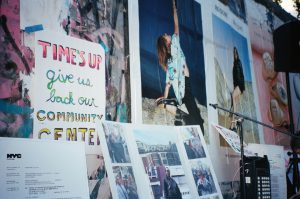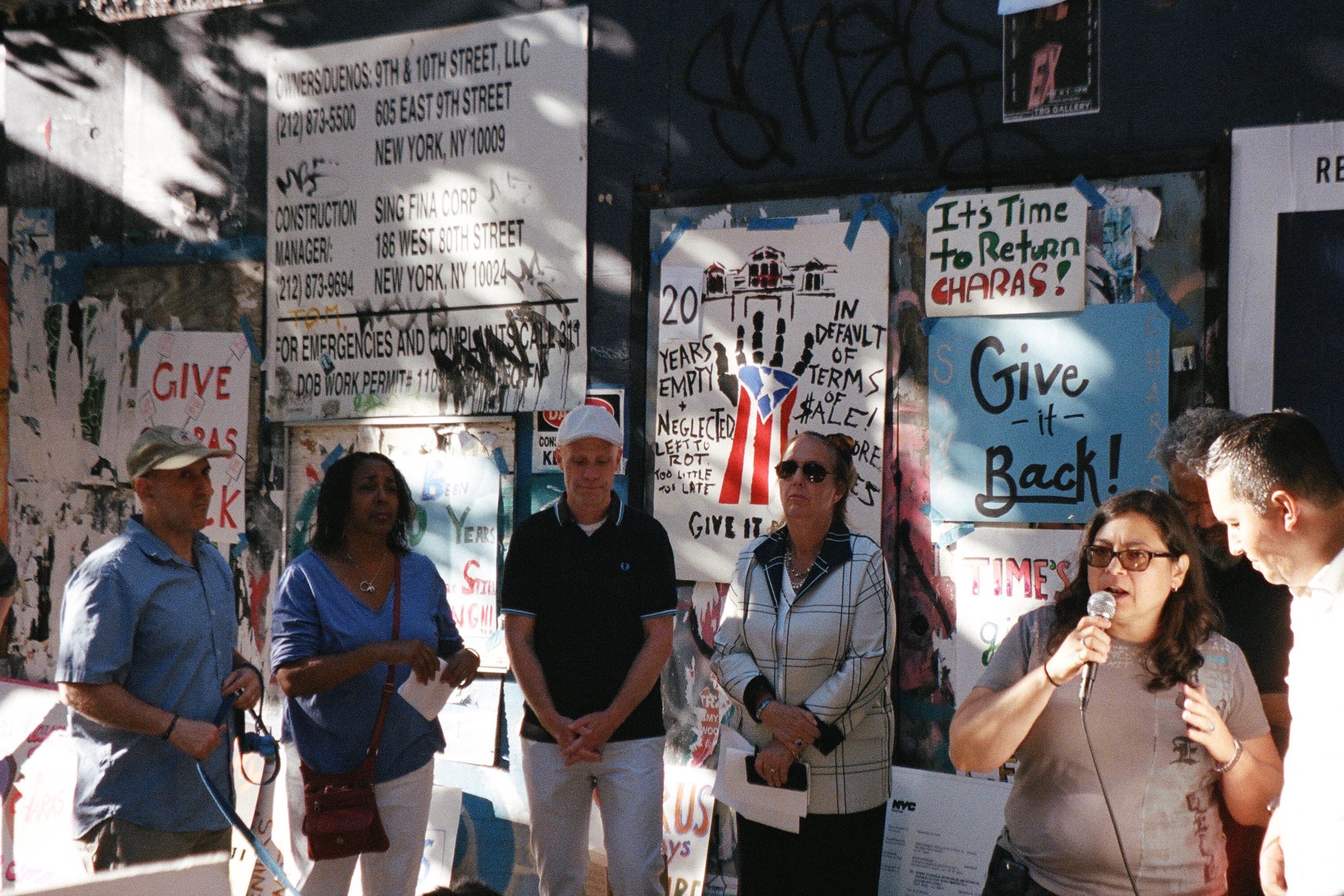On July 20th, 1998, the New York City Police Department evicted CHARAS Community Center from their space on 9th st between Avenues B and C, the former P.S. 64 building. The New York City government, led at the time by Mayor Rudy Giuliani, sold the property to developer Gregg Singer soon after. For the past 20 years, Singer has tried and failed to develop the space, due to significant protest from the community. Currently, the building sits empty and boarded up. On July 20th, 2018, the 20th anniversary of the CHARAS eviction, members of the community came together to hold a rally outside of the building.

Writing for the East Village Patch Joe Dolice noted that there were around 200 people there. Some of the community’s most prominent figures spoke at the rally, including founding member of CHARAS, Chino Garcia, City Councilwoman Carlina Rivera, Assemblyman Harvey Epstein, Manhattan Borough President Gale Brewer, and District Leaders Anthony Feliciano and Rosie Mendez. Each gave emotional speeches about the fight to save the space and their experiences and memories of the value that the center offered to the community. Chino talked about the benefit that the center provided, “We had after-school programs, training programs, bicycle programs and many other projects……the good thing about this building was that you could rent it by the hour or you could get it for free, you know, if you were poor.”
Speakers focused on the key events from the timeline of CHARAS’s more than 20 year history: the intentions of Gregg Singer, Mayor De Blasio’s promises, and the memory of Armando Perez, one of the founders of CHARAS who has killed in 1999. Perez was a role model to many in the community and many of the speakers knew him personally. On display were two expertly crafted papier-mâché puppet heads, about five times the size of a regular head, worn by two protesters. Loisaida Center artists-in-residence Daniel Polnau, Pablo Varona, & Adam Ende crafted a number of larger-than-life puppet heads in 2017, each one an important character in Loisaida history. Many speakers referred to Loisaida, the informal and long-standing Spanglish name for the Lower East Side. Bimbo Rivas’ and Armando Perez’s heads were both displayed at the rally, and speakers evoked them as central figures in establishing CHARAS. Rivas passed away in 1992.
The Loisaida community has fought against Gregg Singer and New York City for a long time, but many people are hopeful that the community will win. After numerous attempts to develop the building into student housing, Singer can use the property as a bank — a process called “land banking” — relying on increasing property values to make a profit at a future date through selling the property. Singer does not need to develop or rent the property to make money on its ownership. Nonetheless, De Blasio has promised to correct the mistake Giuliani made when he sold the building to Singer and buy back the property. Some are skeptical the current mayor will follow through on this vow, although the number of elected officials supporting such an outcome suggests that anything could happen. Right now, the CHARAS community still has the same spirit they had when they were evicted 20 years ago. Only time will tell what is to become of the space.
The large vacant building on 9th street might be surprising to some, as New York is known to be a machine of high priced real estate with seemingly infinite demand. However, CHARAS’s community center is not an unusual sight. Walking through the streets of Manhattan alone, unoccupied storefronts have become a norm, and significantly change the urban fabric of neighborhoods. Such landlords, like Singer, will profit through selling the property at a future time regardless if they leave it unoccupied.
There is a dichotomy that is created out of this, where there is a plethora of empty spaces, while massive amounts of development continue elsewhere. Construction and redevelopment are clearly visible to anyone who has stepped into the streets of New York City. In an interview with Jacobin, David Harvey explains this process through Marxist theory, “If you look at what we did after the 2008 crisis, we added zeroes to the money supply by something called ‘quantitative easing.’ That money then flowed back into stock markets, and then asset bubbles, especially in property markets. We’ve now got a strange situation where, in every metropolitan area of the world that I’ve visited, there’s a huge boom in construction and in property asset prices — all of which is being fueled by the fact that money is being created and it doesn’t know where to go, except into speculation and asset values.”
Harvey points out the situation that New York City is in, where either there is construction that is fueled by land speculation, or those who own land see that their assets will continually become more valuable. Harvey’s point about “spatial fixes” as the interview goes on to record is important to understand in this process. Spatial fixes as Harvey describes it, are the result of having lots of excess capital but no space, so expansion into other parts of the world become the answer for capitalists, and once space in other places runs out, reconfiguration of space becomes the priority, “So that cotton mills in Massachusetts get turned into condominiums.”
A perfect example of this in New York City is the Domino Sugar Refinery in Brooklyn. The complex consisted of a number of buildings which have now been demolished except for the landmarked refinery in the center. The area is slated to turn into a $1.5 billion mixed use development, pointing to just one example of many former industrial areas succumbing to spatial fixes as David Harvey would say. In the year prior to March 2017, foreign investment in real estate rose an unprecedented 49%, half of which was nonresident housing. Harvey pointed out that investment of excess capital from Britain was an essential part of US history in the 19th century, and the Times report confirms that this process has evolved, continuing a foundational American value. New York City has become a place of interest for this kind of investment because of how dependable the market is for increasing asset value. Meanwhile, New Yorkers have seen a noticeable change in the streetscape. Storefront vacancies have changed the street aesthetic. Photographer Todd Heisler captured the vacant storefronts in different neighborhoods of the city as life continues around it. 20% of retail space was vacant in 2017 compared to 7% in 2016. Rents have become too expensive for small businesses and one reason New York Times reporter Corey Kilgannon points to is landlords waiting for redevelopment deals or a lease from big chains. All in all, CHARAS is unique because of its history as a community landmark while it still fits into the current streetscape, with scaffolding and boarded up entrances. At the rally, the presence of picket signs next to advertisements from big fashion brands on the boarded up entrance create an even more intense symbol of capital influencing the visual identity of New York City. CHARAS may someday be a community center again, but if New York continues to become a city for assets instead of people, will a community center have a community? The city is sitting in a precarious position for this matter. The future of New York rests on a fight between capital and community.

